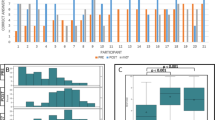Abstract
Decision simulation technology is known to augment health practitioner education and training; little is known about its use for educating lay health practitioners about cancer prevention. We report the development and evaluation of a decision simulation component of a skin cancer risk reduction electronic training (e-training) for massage therapists (MTs). Simulation facilitated tracking and analysis of MTs’ selected dialog options leading to client-focused helping conversations (MT conversations intended to encourage client pro-health behavior) regarding skin cancer risk reduction. The tracking also enabled further assessment of the e-training competencies. We constructed five decision simulation cases in the DecisionSim™ online platform, mimicking MT-client encounters pertaining to skin cancer risk reduction, allowing MTs to apply training knowledge to initiate a helping conversation. We scored each simulation by tracking conversation pathways via selected dialog options (optimal, feedback required, suboptimal), analyzing total scores and real time spent on each case. MTs rated satisfaction with the simulations on a 5-point Likert scale. Eighty-one MTs completed the simulations in an average of 2.7 min. Most (91%) MTs selected feedback required or suboptimal dialog options for at least one of the five cases, often incorrectly choosing conversation statements reflecting their own feelings. The majority (86%) agreed/strongly agreed that they enjoyed the simulations (mean score 4.31); 92% found the simulations helpful to include in the training (mean score 4.36). Decision simulations integrated into e-training are useful for assessing lay practitioners’ practical application of cancer risk reduction knowledge and skills and use of appropriate helping conversations.


Similar content being viewed by others
Data availability
The authors will make all data available upon request.
Code Availability
N/A
References
Gery G, Machlin S, Ekwueme D, Yabroff KR (2015) Prevalence and costs of skin cancer treatment in the U.S., 2002–2006 and 2007–2011. Am J Prev Med 48(2):183–187
Jensen A, Lamberg A, Jacobsen J, Olesen AB, Sorensen H (2010) Non-melanoma skin cancer and ten-year all-cause mortality: a population-based cohort study. Acta Derm Venereol 90(4):362–367
Schmults C, Karia P, Carter J, Han J, Qureshi A (2013) Factors predictive of recurrence and death from cutaneous squamous cell carcinoma: a 10-year, single-institution cohort study. JAMA Dermatol 149(5):541–547
United States Department of Health and Human Services. 2014. Reports of the surgeon general. The surgeon general’s call to action to prevent skin cancer. Washington (DC): Office of the Surgeon General (US).
Cherkin D, Deyo R, Sherman K et al (2002) Characteristics of visits to licensed acupuncturists, chiropractors, massage therapists, and naturopathic physicians. J Am Board Fam Pract 15(6):463–472
Heiligers P, de Groot J, Koster D, van Dulmen S (2010) Diagnoses and visit length in complementary and mainstream medicine. BMC Complement Altern Med 10:3
Nahin R, Barnes P, Stussman B, Bloom B (2009) Costs of complementary and alternative medicine (CAM) and frequency of visits to CAM practitioners: United States, 2007. Natl Health Stat Report 2009(18):1–14
Campbell S, Louie-Gao Q, Hession M, Bailey E, Geller A, Cummins D (2013) Skin cancer education among massage therapists: a survey at the 2010 meeting of the American Massage Therapy Association. J Cancer Educ 28(1):158–164
Loescher L, Howerter A, Heslin K, Azzolina C, Muramoto M (2018) A survey of licensed massage therapists’ perceptions of skin cancer prevention and detection activities. International Journal of Therapeutic Massage and Bodywork 11(4):4–10
Lois L, Heslin K, Szalacha L, Silva G, Muramoto M (2019) Web-based skin cancer prevention training for massage therapists: protocol for the massage therapists skin health awareness, referral, and education study. JMIR Res Protoc 8(5):e13480
Muramoto M, Matthews E, Ritenbaugh C, Nichter M (2015) Intervention development for integration of conventional tobacco cessation interventions into routine CAM practice. BMC Complement Altern Med 15:96
DecisionSim. Decision Simulation Software. https://www.kynectiv.com/
Bernaitis N, Baumann-Birkbeck L, Alcorn S, Powell M, Arora D, Anoopkumar-Dukie S (2018) Simulated patient cases using DecisionSim TM improves student performance and satisfaction in pharmacotherapeutics education. Curr Pharm Teach Learn 10(6):730–735
Curtis M, DiazGranados D, Feldman M (2012) Judicious use of simulation technology in continuing medical education. J Contin Educ Health Prof 32(4):255–260
Everett-Thomas R, Valdes B, Valdes G et al (2015) Using simulation technology to identify gaps between education and practice among new graduate nurses. J Contin Educ Nurs 46(1):34–40
Issenberg B, McGaghie W, Petrusa E, Gordon DL, Scalese R (2005) Features and uses of high-fidelity medical simulations that lead to effective learning: a BEME systematic review. Med Teach 27(1):10–28
Lois L, Heslin K, Silva G, Muramoto M (2020) Partnering with massage therapists to communicate information on reducing the risk of skin cancer among clients: longitudinal study. JMIR Formative Research 4(11):e21309
Polak W, Wiśniowska B, Polak S, Snoch M, Skowron A (2016) Virtual patient case studies in pharmacy education – how to make it work and worth. Sztuka Leczenia 2:43–52
Bateman J, Allen M, Samani D, Kidd J, Davies D (2013) Virtual patient design: exploring what works and why. A grounded theory study Medical Education 47(6):595–606
Acacia O, Storm B (2015) Harnessing the power of uncertainty to enhance learning. Transl Iss Psychol Sci 1(2):140–48
Funding
This study was funded by the Arizona Biomedical Research Centre grant# ABRC / ADHS16-162518.
Author information
Authors and Affiliations
Contributions
All authors contributed equally to this manuscript.
Corresponding author
Ethics declarations
Ethics Approval
The University of Arizona Institutional Review Board approved this study.
Consent to Participate
Informed consent was obtained from all individual participants included in the study.
Consent for Publication
N/A
Competing Interests
The authors declare no competing interests.
Additional information
Publisher's Note
Springer Nature remains neutral with regard to jurisdictional claims in published maps and institutional affiliations.
Rights and permissions
About this article
Cite this article
Heslin, K.M., Silva, G.E., Loescher, L.J. et al. Incorporating Decision Simulation Technology in a Skin Cancer Prevention E-Training for Massage Therapists. J Canc Educ 38, 78–84 (2023). https://doi.org/10.1007/s13187-021-02081-4
Accepted:
Published:
Issue Date:
DOI: https://doi.org/10.1007/s13187-021-02081-4



